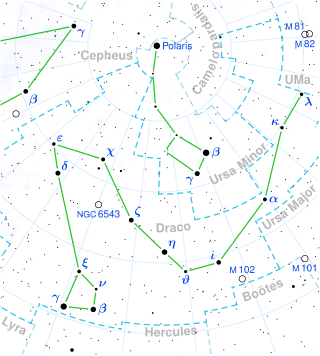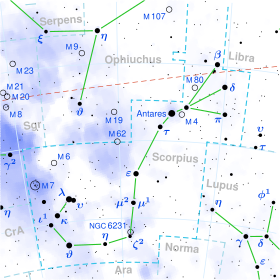
Epsilon Sagittarii, formally named Kaus Australis, is a binary star system in the southern zodiac constellation of Sagittarius. The apparent visual magnitude of +1.85 makes it the brightest object in Sagittarius. Based upon parallax measurements, this star is around 143 light-years from the Sun.

Theta Centauri or θ Centauri, officially named Menkent, is a single star in the southern constellation of Centaurus, the centaur. With an apparent visual magnitude of +2.06, it is the fourth-brightest member of the constellation. Based on parallax measurements obtained during the Hipparcos mission, it is about 58.8 light-years distant from the Sun. It has a relatively high proper motion, traversing the celestial sphere at the rate of 0.73 arcsecond/yr.

Alpha Phoenicis, formally named Ankaa, with the same pronunciation) is the brightest star in the constellation of Phoenix.

Alpha Leporis, formally named Arneb, is the brightest star in the constellation of Lepus.

Epsilon Scorpii, formally named Larawag, is a star in the southern zodiac constellation of Scorpius. It has an apparent visual magnitude of +2.3, making it the fifth-brightest member of the constellation. Parallax measurements made during the Hipparcos mission provide an estimated distance to this star of around 63.7 light-years from the Sun.
Lambda Leonis, formally named Alterf, is a star in the constellation of Leo. The star is bright enough to be seen with the naked eye, having an apparent visual magnitude of 4.32 Based upon an annual parallax shift of 0.00991 arcseconds, it is located about 329 light-years from the Sun. At that distance, the visual magnitude of the star is reduced by an interstellar absorption factor of 0.06 because of extinction.

Rho Scorpii is a double star in the constellation of Scorpius. It has an apparent visual magnitude of +3.87, which is bright enough to be seen with the naked eye. Based upon parallax measurements, it is located approximately 472 light years from the Sun. At that distance, the visual magnitude of the system is reduced by 0.07 due to extinction from interstellar dust. It is a member of the Upper Scorpius OB association.
ω2 Scorpii, Latinised as Omega2 Scorpii, is a suspected variable star in the zodiac constellation of Scorpius. A component of the visual double star ω Scorpii, it is bright enough to be seen with the naked eye having an apparent visual magnitude of +4.320. The distance to this star, as determined using parallax measurements, is around 291 light years. The visual magnitude of this star is reduced by 0.38 because of extinction from interstellar dust.
Zeta Telescopii is the second-brightest star in the southern constellation of Telescopium. It is a solitary, orange-hued star that is visible to the naked eye with an apparent visual magnitude of +4.13. Based upon an annual parallax shift of 25.84 mas as seen from Earth, it is located around 127 light years from the Sun.
Omicron Ursae Majoris, formally named Muscida, is a star system in the northern circumpolar constellation of Ursa Major. It has an apparent visual magnitude of +3.35 and is located at a distance of around 179 light-years from the Sun. In 2012, an exoplanet designated Omicron Ursae Majoris Ab was found to be orbiting the primary.

Gamma Lyrae, Latinised from γ Lyrae, and formally named Sulafat, is the second-brightest star in the northern constellation of Lyra. With an apparent visual magnitude of 3.3, it is readily visible to the naked eye. Parallax measurements yield an estimated distance of 620 light-years from the Sun. At that distance, the visual magnitude of the star is diminished by an extinction factor of 0.12±0.03 due to interstellar dust.

Beta Columbae, officially named Wazn, is the second-brightest star in the southern constellation of Columba. It has an apparent visual magnitude of 3.1, which is bright enough to be viewed with the naked eye even from an urban location. Parallax measurements place it at a distance of about 87.2 light-years from the Sun.

Lambda Draconis, also named Giausar, is a solitary, orange-red star in the northern circumpolar constellation of Draco. It is visible to the naked eye with an apparent visual magnitude of +3.85. Based upon an annual parallax shift of 9.79 mas as seen from the Earth, the star is located around 333 light years from the Sun.
Sigma Hydrae, also named Minchir, is a solitary star in the equatorial constellation of Hydra. It is visible to the naked eye with an apparent visual magnitude of 4.48. The estimated distance to this star from the Sun, based upon an annual parallax shift of 8.75 mas, is around 370 light-years. At that distance, the visual magnitude of the star is diminished by an interstellar extinction factor of 0.16, due to intervening dust.

Psi2 Aurigae, Latinized from ψ2 Aurigae, is a star in the constellation Auriga. It is faintly visible to the naked eye with an apparent visual magnitude of 4.79. Based upon parallax measurements, this star is approximately 420 light-years away from the Earth. At that distance, the brightness of the star is diminished by 0.07 in magnitude from extinction caused by interstellar gas and dust.

Psi7 Aurigae, Latinized from ψ7 Aurigae, is a star in the northern constellation of Auriga. It is a dim, naked eye star with an apparent visual magnitude of 5.02. Based upon Gaia Data Release 2 parallax values, it is approximately 330 light-years from Earth.

Omicron Geminorum, also named Jishui, is a solitary star in the constellation of Gemini. It is faintly visible to the naked eye with an apparent visual magnitude of 4.90. Based upon an annual parallax shift of 19.61 mas, it is located at a distance of 166 light-years from the Sun.
16 Virginis is a single star in the zodiac constellation of Virgo, located about 308 light years from the Sun. It has the Bayer designation c Virginis; 16 Virginis is the Flamsteed designation. This object is visible to the naked eye as a faint, orange-hued star with an apparent visual magnitude of 4.96. This is an IAU radial velocity standard star; it is moving further from the Earth with a heliocentric radial velocity of +37 km/s. The star has a relatively high proper motion, traversing the celestial sphere at an angular rate of 0.301″ per year.
7 Draconis, also named Tianyi, is a single star in the northern circumpolar constellation of Draco. It is visible to the naked eye as a faint orange-hued star with a stellar classification of 5.43. Based upon an annual parallax shift of 4.16 mas as seen from the Earth, the star is located approximately 780 light-years from the Sun.
HD 166006, also known as HR 6778, is a solitary orange-hued star located in the southern constellation Telescopium. It has an apparent magnitude of 6.07, making it barely visible to the naked eye. Based on Gaia DR2 parallax measurements, the object is located 582 light years away. It is currently approaching the Solar System with a somewhat constrained heliocentric radial velocity of −15 km/s.












